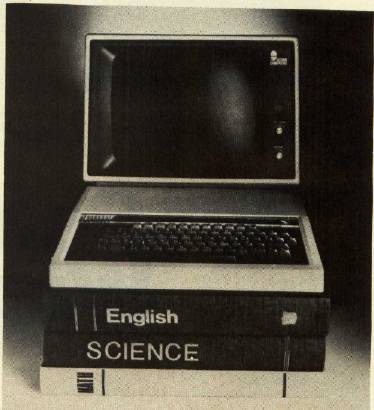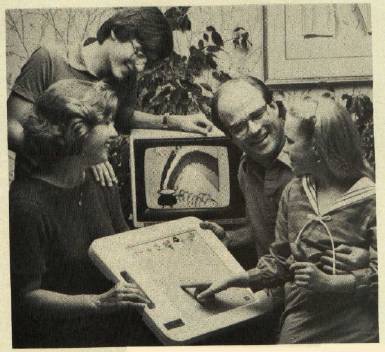On The Road With Fred D'lgnazio
The Electronic Chalkboards: The BBC And The Powerpad
The Only Computer To Have When You're Having More Than One
Last spring I went to London and taught a course on robotics literacy. According to the Daily Telegraph, the classroom where we met was like a "composite of several scenes out of Dr. Who." We had robot turtles and robot buggies rolling around on the floor, and robot arms waving and weaving on the tops of our desks. And we had 15 BBC microcomputers linked together in the BBC's Econet local area network. The students used the BBCs to control the robot arms, to learn Logo and BASIC, and to perform experiments with robot sensors.
The 15 BBCs all received their programs from a single disk drive (the fileserver) in the front of the classroom. They all used a single printer (the printserver) to type out files, programs, and student papers and assignments.
David Barnett, the course's computer instructor, used a BBC as the demonstration computer. David's BBC was connected to a large television set mounted on a shelf so all the students could see it. The computer acted like the course's electronic chalkboard. David ran programs on his computer, and they appeared on the big TV. Then he pressed a button, and a copy of his computer's screen appeared on the screens of all the students' computers.
The system was even more flexible than this. The students all worked on individual and team projects. When they finished their projects, they made presentations. To aid their presentations the students could send copies of their screens to all the other students' screens.
And David, in front of the class, could help individual students if they got bogged down in a program. By pressing a couple of buttons on his computer, he could take a snapshot of the screen on a student's computer. After studying the student's problem, he could take control of the student's keyboard and type in a command or piece of information. The student could watch all this on his or her own screen. A moment later, David would return control to the student, and the student could resume running the program on his own.
This was a tremendous feature. When I am teaching a course and a student asks me a question, I often have to sit down at the student's computer in order to decide what is going on and what to suggest. If you have 15 students, and they are all asking questions, it can get pretty hectic running from computer to computer.
The BBC network eliminates this problem. You can stay seated at your own computer and, with the push of a button, you can "hop" to any student's computer, diagnose his or her problem, and enter the appropriate response. This feature alone, in my opinion, makes the BBC network extremely valuable.
The Only Computer That Majors In Education
Acorn Computers Ltd. sells the BBC computer in England. Its subsidiary, Acorn Computers Corporation, is now selling the BBC in the United States. Acorn can be reached at:
Acorn Computers Corporation
400 Unicorn Park Drive
Woburn, MA 01801
(617)935-1190
The company is concentrating its efforts exclusively on the $700 million US education market. Two years ago, the Acorn computer won a contest sponsored by the British Broadcasting Corporation and was given permission to name its computer the BBC. Acorn has since sold BBC computers to 85 percent of British primary and secondary schools. This amounts to 150,000 computers already installed and 30,000 new computers going out each month.

The US version of the computer is equivalent to the more powerful BBC/B version. For the hefty $995 price tag, you do not get a monitor, a printer, or a disk drive. But you do get 64K RAM/ROM, an additional 80K ROM, built-in BASIC, a (TI) voice synthesizer, built-in word processing, high-resolution graphics (640 × 200 pixels), multi-channel sound, and a software switchable 40- or 80-character screen.
The computer comes with either an RS-423 or Centronics parallel port and with the Econet network interface built-in. The actual network, including software, costs $595, and enables you to connect up to 254 computers on an inexpensive, four-wire, telephonelike cable. The 6502 processor can be augmented to include an additional 6502 processor, or a Z80, or 32-bit National Semiconductor 16032 processor.
A 440K disk drive costs an additional $545; an 800K disk drive costs $995. Acorn offers a monochrome monitor for $195. The computer will support any of the popular printers, over the serial or parallel ports.
I know from having used the computer in England that the operating system and the computer's version of BASIC are a programmer's delight — extremely powerful yet simple to use. But Acorn's marketing strategy in the US will focus on the software that has been developed for the machine. Two hundred fifty educational packages have already been created for the BBC and approved by Acorn's prestigious nine-member Educational Advisory Board.
In addition, 2,500 software companies produce software for the BBC in England and in Western Europe. Many of these companies are modifying and enhancing their packages so they will meet the board's approval and be available on the US version of the machine.
We Give Courses On How To Give Courses
According to Harvey Lawner, general manager and senior vice president of Acorn (US), "Education is our main business. It is not an after-thought." Lawner is critical of computer companies that concentrate on getting a computer into a classroom, but do not provide direct and immediate support. "We aren't just selling a computer," Lawner contends. "We are selling a total learning system."
Lawner's national marketing director, Bob Angelo, contrasts his company's approach with the hardware-first approach adopted by other American companies. "They're selling boxes," he says. "We're selling solutions."
For an educational software package to be approved by the Educational Board, it must be supported by a lesson plan, a student's workbook, a teacher's guide, student notes, and (when appropriate) student experiments. This print component forms an integral part of Acorn's effort to turn the computer into a tool that any teacher can use no matter how little experience he or she has had with a computer.
Acorn's philosophy is to package the BBC in a way to make it as familiar as possible to the average teacher. The software, for example, comes in boxes that look like quality, hardcover, linen textbooks.

According to Angelo, Acorn isolated two problems which have inhibited the introduction of microcomputers in the classroom. First, most of the software currently appearing in the classroom is often three to four years old, or even much older. The old software does not reflect the newest philosophies in educational computing and does not make use of the advanced hardware capabilities of the newer microcomputers.
Second, computers in school are being used only by a relatively small number of teachers and students. Most teachers are fearful of the computers and don't see how a computer can make a valuable contribution to their own teaching.
Angelo says that Acorn will attack both these problems head on. First, Acorn is commissioning the development of a huge quantity of new software for use in classrooms on the BBC computer. Second, the Acorn board is helping software companies to translate to the BBC the best new software currently running on other machines.
Chalk Board's PowerPad
Last week I flew to New York and got a chance to preview one of the most exciting new products on the market — the PowerPad, a touch-sensitive tablet in a 20-inch-by-17-inch hard plastic case. The PowerPad plugs into VIC-20, Commodore 64, IBM PC, Apple, and Atari computers.
The PowerPad can replace the keyboard as the primary means of inputting information into the computer, especially for children. It has numerous mylar overlays which easily clip on top of the 12-inch-by-12-inch touch-sensitive pad. Each overlay is a new keyboard, a keyboard with colorful shapes and figures.
The PowerPad has only a few "keys" on each overlay, so the child or the beginning user isn't overwhelmed by choices.
The "keys" are large and in bright primary colors. Printed on them are bold words (RED or PLAY) and symbols such as # or *. They are separated by plenty of space to make typing simple.
The PowerPad features a novel design in which signals from the tablet are digitally sensed and encoded. A grid of 14,400 contact points (100 points per square inch) is sandwiched inside the PowerPad. The points can record one contact at a time or a dozen contacts. Older touch pads can sense only one finger at a time. But kids (and adults) can put all their fingers on the PowerPad at the same time, and the PowerPad will sense all of them and transmit the proper signals to the computer.
This capability is especially nice with the PowerPad's music software and overlay, Micro Maestro. The overlay has a piano keyboard at the bottom and a musical score in the middle, with colorful "buttons" for each note on the score. A child can play a musical chord on the piano keyboard by pressing all three fingers on different keys at the same time. This would be impossible on any other touch pad.

Another software-and-overlay package, Leo's 'Lectric Paintbrush, helps a child create colorful pictures on the computer. Again the multicontact feature of the PowerPad becomes especially useful. Before drawing each new part of the picture, the child can press the Pen Up button on the upper left-hand corner of the PowerPad. Immediately a pen tip appears. The child can change the color of the ink being used by pressing one of the colorful paint keys on the upper right-hand corner of the board. When the child picks a new color, the color of the pen tip changes to that color.


Leonardo's Library
The PowerPad costs $99.95. It is supported by a large and growing body of educational software, called Leonardo's Library. Programs in the library will cost between $25 and $50. The library will include programs focusing on visual arts, music, math, science, language arts, and social studies. Included among the first programs are:
- Leo's 'Lectric Paintbrush. An electronic finger-painting kit.
- Micro Maestro. Turns the PowerPad into a piano keyboard.
- Music Math. Lets children explore the relationships between math and music.
- Programmer's Kit. Lets older children and adults write their own software and develop their own creative uses for the PowerPad.
PowerPads and programs in Leonardo's Library are already available at K mart, Apple Computer dealers, and many other computer and discount stores. If you would like to know more about the PowerPad, you can contact Chalk Board directly:
Chalk Board, Inc.
3772 Pleasantdale Road
Atlanta, GA 30340
(404) 496-0101